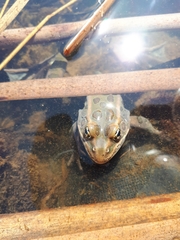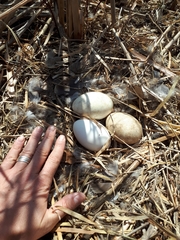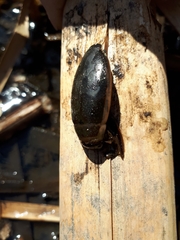8 days, St. François Xavier and Lichens
St. François Xavier North 14PA03 is located in the RM of St. François Xavier, the RM of Woodlands and the RM of Rosser. The Red River flows through the southwest quarter of the square. Several parallel drains cross the square joining Sturgeon Creek to the east. Agriculture dominates the land use in this square.
At the time of posting, 13 observations of 9 species had been uploaded by 2 observers led by @colinmurray . This is the first square that we have come across where no observation of a plant has been recorded....yet. Insects and amphibians each have 3 observations. The survey for the Breeding Bird Atlas of Manitoba confirmed 20 bird species nesting here, with another 66 species probable or possible. Here's the full list.
Lichens can be found growing on the surfaces that seem inhospitable to other organisms - places like cement sidewalks and tree trunks. They are often quite small to start with and those who study them often rely on very tiny features to identify them. Observations of these organisms are better if they have both a general shot of the organism showing the habitat it is living in as well as very close-up details of the different structures that make up the whole.
Jennifer Doering at the University of Manitoba suggests:
Charles Burchill's site is a good resource for Manitoba lichens. A lot of the species he lists are boreal or northern, but a few species to note that would be common with the Aspen Parkland and Winnipeg area are:
Caloplaca spp. - orange crustose lichen that grows commonly on large boulders
Candelaria spp. - yellow crustose lichen that grows commonly on conifer tree bark
Candelariella spp. - yellow crustose lichen that grows on tree bark, can find on oak and ash trees
Cladonia spp.. - fruticose, pixie cup lichens commonly found on the bottoms of trees, logs, and moist soils in forest understory
Lecanora spp. - grey crustose lichens with rimmed black or brown sexual structures commonly found on rocks
Lecidea spp. - grey crustose lichens with brown or black "warts" sexual structures commonly found on rocks
Parmelia sulcata - grey foliose lichen with dark brown to black underside commonly found on conifers
Physcia aipolia - grey foliose lichen, smaller than Parmelia, common on most tree bark
Peltigera spp. - large, lobed lichens that can be green, grey or black growing in moist mossy areas within forests (usually coniferous)
Xanthoria parietina - orange to yellow-orange crustose lichen that grows commonly trees, along with Physcia spp.
Flavopunctelia flaventior - pale greenish lobed lichen very common on aspen and oak trees, especially in Assiniboine forest.
Troy McMullin, lichenologist at the Canadian Museum of Nature suggests
The first step is learning to tell a lichen from a moss or fungi. The easiest way is that they are pastel colours and are hard and fragile when dry and soft and malleable when wet.
Interested in diving deeper? "Getting to Know Saskatchewan Lichens, a booklet for the beginner-- Lichens of the Prairie, Aspen Parkland and Boreal forest by Bernard De Vries published by Nature Saskatchewan is a good beginner field guide for our area.
More reading....
- What’s that stuff on my tree? A guide to Manitoba’s lichens Dr. Diana Robson, Curator of Botany, Manitoba Museum
- Consortium of North American Lichen Herbaria
- Air Pollution and the Distribution of Epiphytic Lichens and Bryophytes in Winnipeg, Manitoba Paul W. Stringer and Muriel H. L. Stringer, 1974








Comentários
Adicionar um Comentário